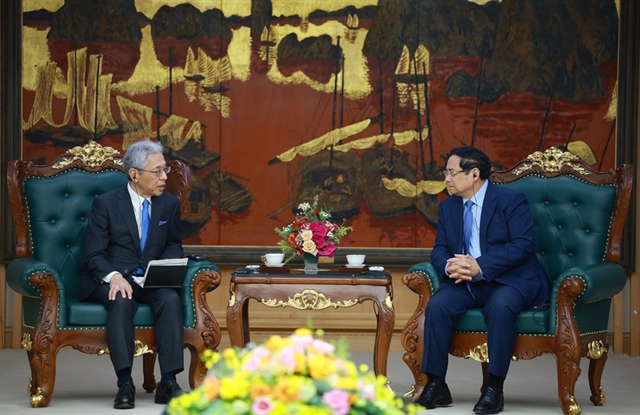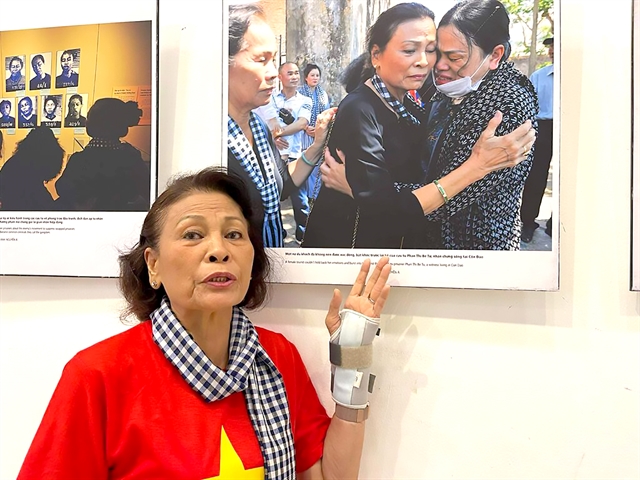 Society
Society

 |
| Phan Thị Bé Tư shows a photo of a female tourist who was moved to tears and embraced her after hearing her story during a visit to Côn Đảo. — VNA/VNS Photo |
BÀ RỊA-VŨNG TÀU — Decades after the end of the war in Việt Nam, former political prisoners are revisiting the sites of their incarceration and torture, sharing harrowing accounts of sacrifice and resilience that they say underpinned the struggle for national reunification.
Among them is Phan Thị Bé Tư, who lives in HCM City, who recently joined fellow former inmates on a return trip to Côn Đảo Prison in Bà Rịa - Vũng Tàu Province, a notorious penal colony off the southern coast where many Vietnamese revolutionaries were held and brutalised.
The visits serve as a pilgrimage to honour fallen comrades at Hàng Dương and Hàng Keo cemeteries, and to remember the brutal conditions endured.
"We cannot forget that painful memory," Tư said. "We want to tell our children and the next generation that today's peace and independence were paid for with the blood and bones of countless revolutionary soldiers who came before us."
Before being sent to Côn Đảo, Tư was held in multiple prisons run by the US-backed South Vietnamese government. She recounted enduring repeated, savage beatings and torture, particularly targeting sensitive areas when she refused to provide information.
Recalling the period leading up to the 1968 Tết Offensive, she described being captured with comrades after attending a training session. Interrogators force-fed her water before kicking her stomach and used wet sacks combined with electric shocks. She was also forced to inhale a mixture of fish sauce and chilli.
"They tied my hands and feet and applied electricity to my private parts," she said.
"When I didn't confess, they poured water down my throat and kicked me until I vomited. Then they put a wet sack on me and electrocuted me. They also mixed fish sauce with chilli and forced it into my nostrils. They beat me unconscious, and when I woke up, they asked about the organisation. If I didn't confess, they beat me again."
Transferred between prisons, including the Chí Hòa Prison in Hồ Chí Minh City (then Sài Gòn), she faced pressure to salute the flag of the South Vietnamese regime. "I said I only salute the flag of the Fatherland, not the three-stripe flag," she recalled. "They immediately beat me in revenge. In my cell, some people were tortured to death."
In late 1969, news of late President Hồ Chí Minh's passing reached Chí Hòa. Tư said prisoners improvised mourning rituals, tying white strips on their heads. This act of defiance by hundreds of inmates reportedly alarmed the authorities, leading to increased repression before she and many others were transferred to Côn Đảo.
Lê Thị Đức, another former prisoner, now living in HCM City, was just over 18 when she was sent to Côn Đảo. Captured during the second wave of the 1968 Tết Offensive, she spent nearly a year in various prisons before her transfer.
"For four years there, I suffered all kinds of cruel torture from the enemy," she said. "Beaten within an inch of my life, but we still did not surrender."
Historical accounts and the testimonies of former prisoners like Tư and Đức highlight the extensive prison system established by the South Vietnamese government and their US allies after the 1954 Geneva Accords divided the country.
This network, comprising over 300 prisons and detention centres, aimed to suppress patriotic and revolutionary movements.
More than 700,000 individuals, including party members, intellectuals and suspected dissidents, were imprisoned and subjected to brutal interrogation and torture.
Côn Đảo held over 200,000 people during its operation, with 40,000 revolutionary soldiers reportedly killed there.
The objective, according to the narrative from the former prisoners and state accounts, was to force them to renounce their political affiliations or perish under inhumane conditions.
The 'tiger cages' (chuồng cọp) at Côn Đảo were particularly infamous for their barbarity, gaining international attention after reports surfaced in the US press describing the horrific conditions.
One widely cited example detailed a 16-year-old high school student imprisoned in a cage for refusing to salute the Southern Vietnamese regime's flag, reportedly suffering permanent spinal damage after being hung from a hook.
Despite the extreme suffering, the former prisoners emphasised that their spirit of resistance remained unbroken. They continued political education, planning acts of defiance, singing revolutionary songs, and reciting poetry, including President Hồ Chí Minh's verses written in prison: "The body is in prison, the spirit is outside."
Tư, holding a book titled Former Côn Đảo Prisoners - The Day of Return, pointed to its cover photo showing a tourist tearfully embracing her on a return visit to Côn Đảo as she recounted her story.
She explained that her revolutionary family background and the sacrifice of her brother, killed fighting US and South Vietnamese forces, fuelled her determination.
"Being about to become a full Party member meant I would not allow myself to do anything contrary to the nation, contrary to the people," she said.
"That helped me endure the enemy's savage torture. But above all, we did not think about ourselves but always stood ready to make the sacrifice for the belief that the day of national reunification was approaching." — VNS




